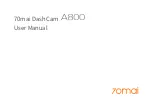
The USB 2.0 microcontroller interface
The interface board is a miniature PCB contained
within the camera body (figure 3.3) and serves as
the means by which images from the sensor chip
are served to the software application on the
user’s host computer via the USB 2.0 UVC
protocol. The camera has an approximately 42 cm
long USB 2.0 cable that is connected to this
microcontroller inside the camera body and the
other (free) end of the USB cable has a ‘type A’
male USB connector for connecting to a host
computer.
This microcontroller also serves as the means by
which the user may communicate with the camera
electronics to adjust certain parameters for
imaging such as exposure, focus control, image
resolution, image output format, etc..
While the sensor chip itself has many options for programming and adjusting it’s SOC
features, some of these options are only adjustable to hardware developers in the factory
using specialist development interface boards. Not all of those features are programmable
or controllable by the end user of the camera. For example the LENC gain pattern across
the sensor has been programmed at the factory and cannot be altered by the end user via
the the USB 2.0 interface board.
The features provided to the user by the USB 2.0 microcontroller interface are therefore
the only parameters that may be adjusted by the user using suitable software on their
computer (more will be said about the suitable / available software later). The following
features are provided by the interface board for the user to adjust. There are some known
‘quirks’ or unintuitive behaviour of these settings which are explained in the notes in each
section below.
The firmware in the interface board divides the controls into two groups: ‘User Controls’
and ‘Camera Controls’.
OptArc AF51 Camera Page 24 of 99 User Guide v1.02
Figure 3.3 The USB 2.0 Microcontroller
board in the AF51 camera housing.
















































